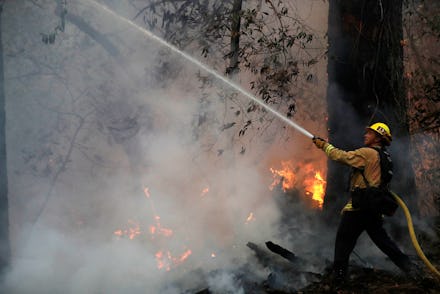Why you should pay attention to California’s wildfires, even if you live several states away

The wildfires raging through northern California have claimed the lives of 41 people, turned an estimated 5,700 structures to ash and have ravaged an astonishing 213,000 acres of land.
These fires are particularly dangerous thanks to their proximity to major metropolitan areas, as Jan Null, adjunct professor at San Jose State University and a certified consulting meteorologist with Golden Gate Weather Services, said in a phone interview with Mic.
“As far as the total area burned, we’ve had significantly bigger fires,” Null said. “This is not going to rank as one of the biggest fires. The fact that it occurred adjacent to a metropolitan area, Santa Rosa, which has a population, including the whole metro area, of about 200,000 people — that’s when we see these really destructive fires, is when they occur in the wildland interface between wildlands and urban areas.”
However, just because you live far, far away from Santa Rosa doesn’t mean you’re out of danger.
As the San Francisco Chronicle reported, smoke from the fires currently engulfing northern California has already traveled as far south as Mexico, or more than 550 miles from where it originated. And it is that giant plume of smoke that can have the longest tail effect on health.
“Over the past two days we’ve experienced unprecedented levels of air pollution in the region,” Kristine Roselius, spokeswoman for the Bay Area Quality Management District, told Wired. “It’s very difficult to forecast what the air quality will be at any moment because we’ve still got active fires.”
With all that smoke comes what is known as particulates, or fine particles that are less than 2.5 microns or less in diameter. These tiny particles can get into your eyes, nose, lungs or even your bloodstream, causing irreversible damage, according to Dr. Gopal Allada, a pulmonologist and critical care specialist at Oregon Health & Science University who spoke to NPR about the dangers of fire smoke in September.
“This is not good for our lungs,” Allada said. “When you inhale these really small particles, smaller than a few microns, they can land in your lungs and cause respiratory symptoms.”
These symptoms, he added, can include chest pain, irregular heartbeat or even cause heart attack. And while the risk is minimal to healthy, active adults, it can lead to devastation for those already suffering from chronic illness, the elderly, pregnant women or children. The fastest solution? A high-quality air filter for your entire home, especially if you’re in a high-risk group. The long-term solution? Start caring about climate change.
As Rachel Cleetus, lead economist and climate policy manager with the climate and energy program at the Union of Concerned Scientists, said in July, “The reality is that, in the southwest and the western U.S., hotter, drier conditions — which climate change is a big contributing factor towards — are making our fire seasons more fierce and longer.”